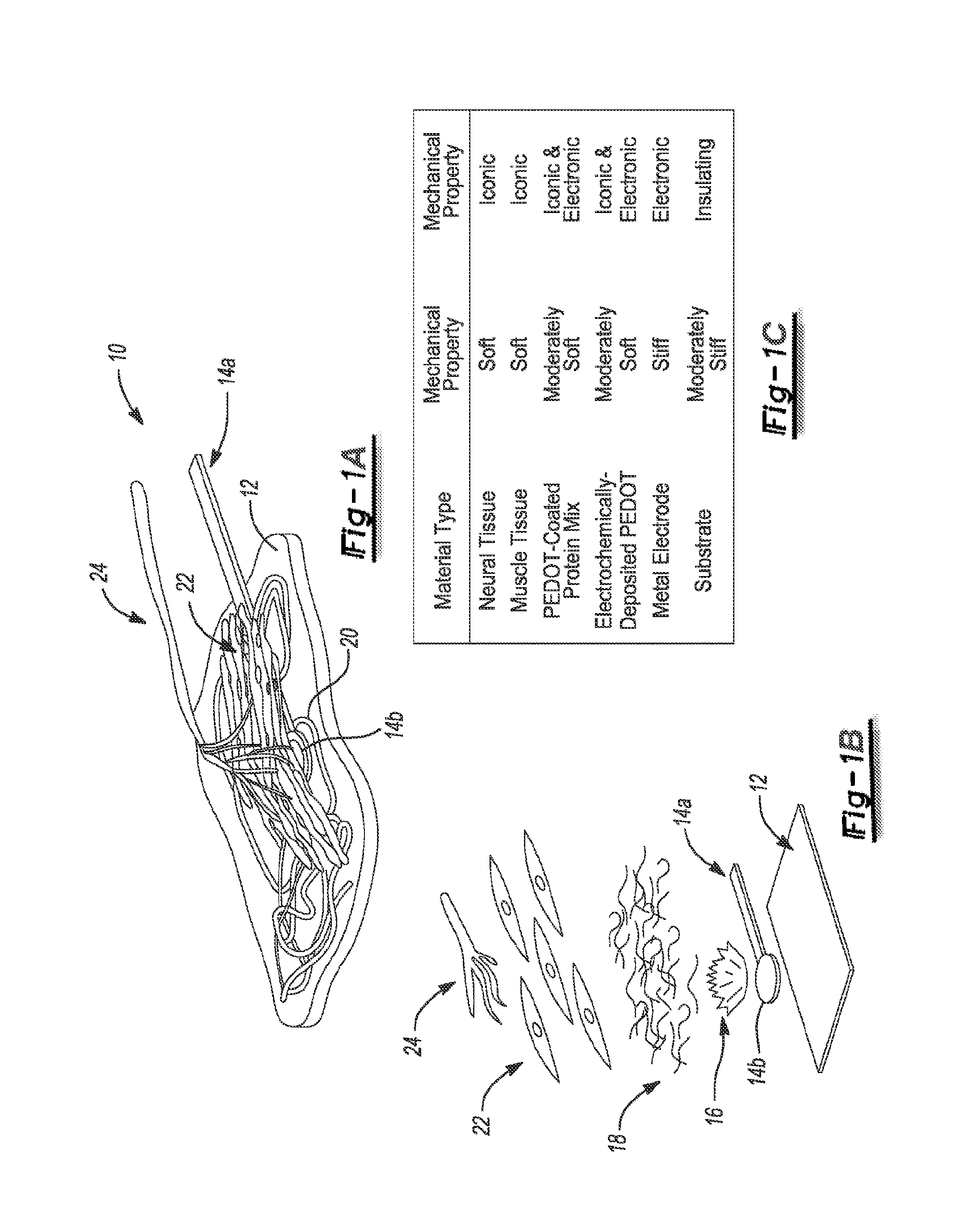Regenerative peripheral nerve interface
a peripheral nerve and interface technology, applied in the field of regenerative peripheral nerve interface, can solve the problems of axonal damage threatening the fidelity of the device, signal degradation and failure gradually occurring, and difficult to interface these machines with living tissues
- Summary
- Abstract
- Description
- Claims
- Application Information
AI Technical Summary
Benefits of technology
Problems solved by technology
Method used
Image
Examples
example 1
Nerve Regeneration in the Presence of Conductive Polymers
[0075]In the following example, an amputee's residual peripheral nerves are interfaced with processors that receive and transmit signals for prostheses control. PEDOT (3,4-polyethylenedioxythiophene) is an anisotropic, conductive polymer that beneficially reduces tissue impedance. PEDOT can be polymerized into nonconductive, processed decellular nerve (DN) leaving it highly conductive but stiff (DryPEDOT), or, less conductive but pliable (WetPEDOT). The nerve regeneration was tested in a rat peripheral nerve interface (PNI) environment and PEDOT biocompatibility was also evaluated.
[0076]A 15 mm, peroneal nerve gap was reconstructed with one of five nerve derived materials: Sham, Autograft, DN, DryPEDOT, and WetPEDOT, or not reconstructed: Gap, (n=8 / group). A single layer of acellular submucosa surrounded each graft as in peripheral nerve interfaces. After 90 days, evaluations were completed for muscle force, nerve conduction, ...
example 2
Long Term Stability of Regenerative Peripheral Nerve Interfaces (RPNI)
[0079]Stability of Regenerative Peripheral Nerve Interfaces
[0080]An amputee's peripheral nerves with neuro-prosthetic arms possessing the latest robotic technology are interfaced. The regenerative peripheral nerve interface (RPNI) is constructed by implanting syngeneic muscle cells from one of two stages of muscle development, immature (myoblast) or mature (transferred muscle). A construct is formed from a decellular muscle with or without the conductive polymer poly(3,4-ethylenedioxythiophene), or PEDOT, which supports the muscle cells and allows implantation of the transected residual nerve within the RPNI. For all RPNI, spontaneous EMG, nerve conduction, and neuromuscular junction formation following in-situ maturation occurred. RPNI were sustained long term for both the myoblast and the muscle transfer groups.
[0081]Animal care and operative procedures were performed in accordance with the United States Public ...
example 3
Peripheral Nerve Interface to Thin-Film Polyimide Electrode Arrays
[0084]In the following example, a peripheral nerve interface to provide motor signals to and record sensor feedback from prostheses is developed. In this study, a thin film polyimide electrode array as a peripheral nerve interface-signal recording probe was tested. The feasibility of array in terms of biocompatibility, material integrity (electrical and mechanical) and surgical availability was also tested.
[0085]The thin-film electrodes are microfabricated polyimide thin-film arrays developed and provided by NeuroNexus Technologies, Inc. The design space of this technology provides a large variability in terms of electrode size, placement and packaging for chronic preparations. The arrays were flexible, planar, 15 microns thick with 32 regularly spaced electrode channels. In the surgical procedure, the rat peroneal nerve was exposed and divided. The thin-film polymer arrays were implanted around the proximal stump as ...
PUM
| Property | Measurement | Unit |
|---|---|---|
| length | aaaaa | aaaaa |
| length | aaaaa | aaaaa |
| length | aaaaa | aaaaa |
Abstract
Description
Claims
Application Information
 Login to View More
Login to View More - R&D
- Intellectual Property
- Life Sciences
- Materials
- Tech Scout
- Unparalleled Data Quality
- Higher Quality Content
- 60% Fewer Hallucinations
Browse by: Latest US Patents, China's latest patents, Technical Efficacy Thesaurus, Application Domain, Technology Topic, Popular Technical Reports.
© 2025 PatSnap. All rights reserved.Legal|Privacy policy|Modern Slavery Act Transparency Statement|Sitemap|About US| Contact US: help@patsnap.com



